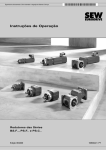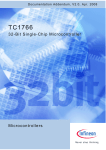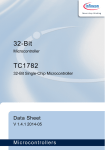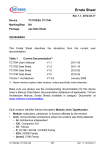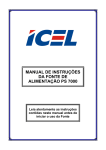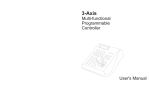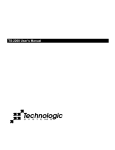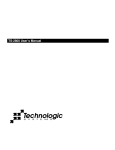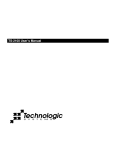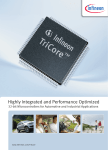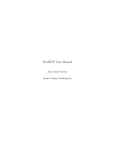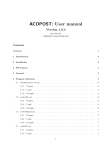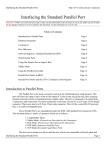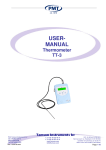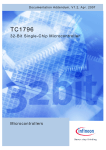Download Queued SSC - description
Transcript
Tri Cor e AP 3217 2 Queued SSC Applic atio n N ote V1.0 2011-09 Mic rocon t rolle rs Edition 2011-09 Published by Infineon Technologies AG 81726 Munich, Germany © 2011 Infineon Technologies AG All Rights Reserved. LEGAL DISCLAIMER THE INFORMATION GIVEN IN THIS APPLICATION NOTE IS GIVEN AS A HINT FOR THE IMPLEMENTATION OF THE INFINEON TECHNOLOGIES COMPONENT ONLY AND SHALL NOT BE REGARDED AS ANY DESCRIPTION OR WARRANTY OF A CERTAIN FUNCTIONALITY, CONDITION OR QUALITY OF THE INFINEON TECHNOLOGIES COMPONENT. THE RECIPIENT OF THIS APPLICATION NOTE MUST VERIFY ANY FUNCTION DESCRIBED HEREIN IN THE REAL APPLICATION. INFINEON TECHNOLOGIES HEREBY DISCLAIMS ANY AND ALL WARRANTIES AND LIABILITIES OF ANY KIND (INCLUDING WITHOUT LIMITATION WARRANTIES OF NON-INFRINGEMENT OF INTELLECTUAL PROPERTY RIGHTS OF ANY THIRD PARTY) WITH RESPECT TO ANY AND ALL INFORMATION GIVEN IN THIS APPLICATION NOTE. Information For further information on technology, delivery terms and conditions and prices, please contact the nearest Infineon Technologies Office (www.infineon.com). Warnings Due to technical requirements, components may contain dangerous substances. For information on the types in question, please contact the nearest Infineon Technologies Office. Infineon Technologies components may be used in life-support devices or systems only with the express written approval of Infineon Technologies, if a failure of such components can reasonably be expected to cause the failure of that life-support device or system or to affect the safety or effectiveness of that device or system. Life support devices or systems are intended to be implanted in the human body or to support and/or maintain and sustain and/or protect human life. If they fail, it is reasonable to assume that the health of the user or other persons may be endangered. AP32172 Queued SSC TC1782 Revision History: V1.0, 2011-09 Martin Schrape Previous Version: Page Subjects (major changes since last revision) We Listen to Your Comments Is there any information in this document that you feel is wrong, unclear or missing? Your feedback will help us to continuously improve the quality of this document. Please send your proposal (including a reference to this document) to: [email protected] Application Note 3 V1.0, 2011-09 AP32172 Queued SSC Table of Contents Table of Contents 1 Preface ................................................................................................................................................ 6 2 Introduction ........................................................................................................................................ 7 3 Configuration ...................................................................................................................................... 7 4 4.1 4.2 4.3 Example Application ........................................................................................................................ 10 Example 1 .......................................................................................................................................... 10 Example 2 .......................................................................................................................................... 12 Example 3 .......................................................................................................................................... 14 5 Tools .................................................................................................................................................. 16 6 Source code ...................................................................................................................................... 16 7 References ........................................................................................................................................ 16 Application Note 4 V1.0, 2011-09 AP32172 Queued SSC Preface 1 Preface This application note describes the implementation of a queued serial communication on the TriCore architecture [1] for the AUDO MAX-family. Queued serial communication is extremely helpful when multiple external devices are connected to one SSC interface and when the communication should be serviced quickly and with low or no CPU load. Up to eight slaves are possible on one SSC master. The application note explains the configuration of the build-in queued Synchronous Serial Communication (SSC) mode as well as alternative methods which uses the PCP. The document is aimed at developers who write or design real-time applications on the TriCore which uses the SSC interface to communicate with either multiple similar slave devices like Digital to Analog Converters (DAC), field bus chips or position encoders or different slave devices on the same SSC module. This guide assumes that readers have access to the TriCore Architecture Manual [2] and the TC1782 Users Manual [3], and have at least some general knowledge of TriCore instruction set, the architectural features and peripheral modules especially the DMA and the standard SSC functionality. See References on page 16 for more information on the TriCore and other relevant documentation. Figure 1 TC1782 Block Diagram Application Note 6 V1.0, 2011-09 AP32172 Queued SSC Introduction 2 Introduction Figure 1 shows the TC1782 block diagram. Modules used in this application note are marked yellow. This section 2 gives an introduction to the principles of the queued SSC mode. With the queued SSC mode the TriCore can control multiple SSC slaves with different configurations like baud rates, data width and byte order. In this case, the control and data handling for an SSC slave is handled by multiple DMA channels. Section 3 explains a configuration and initialization of the DMA and SSC module to use the queued SSC mode. Section 4 illustrates three example applications that are provided with this application note. The examples are considering slave devices like DAC which has only a a Write interface. The queued SSC mode does also support Write as well as Read interfaces, so that e.g. field bus chip (R/W) or position encode (W) could use this mode but these devices are not in the scope of this application note. 3 Configuration The SSC configuration is controlled by four registers (Table 1): the Control Register CON (see page 10), the Baud Rate Timer Reload Register BR, the Slave Select Output Control Register SSOC and the Slave Select Output Timing Control Register SSOTC (see page 10). These registers are located directly behind each other in the address space. The basic idea of the queued SSC mode is that one DMA channel moves a configuration from an internal buffer of n × 4 words to these four registers and then issues a request to a second DMA channel that send the data to the transmit buffer (Figure 2). The four registers can be easily addressed using a circular 16 byte buffer for the destination of the first DMA channel. During the modification of the SSC configuration the SSC needs to be disabled and reenabled when the configuration is finished. Therefore the enable bit is found twice in the module registers. The control register which is accessed first by the DMA holds a CON.EN bit, so that the first DMA move can disable the module, the subsequent 3 moves modifies the configuration but the last move to the SSOTC register is also used to re-enable the module. The SSCOTC register holds another enable bit SSCOTC.EN and a queued SSC Mode control bit SSC0TC.QSMEN. If both bit are set the module will be enabled (Figure 4). To service multiple transmission without any CPU interaction the SSC generates a request from the receive data buffer SSC0_RDR that is used as a hardware request to start the next transfer of the next SSC configuration by the first DMA channel (Figure 3). Table 1 SSC Register Overview used for Queued Mode Register Short Name Register Long Name Offset Address CON Control Register 10H BR Baud Rate Timer Reload Register 14H SSOC Slave Select Output Control Register 18H SSOTC Slave Select Output Timing Control Register 1CH Figure 2 SSC Interrupt Control Application Note 7 V1.0, 2011-09 AP32172 Queued SSC Configuration Figure 3 SSC0 Module Implementation and Interconnection Figure 4 Queued SSC Mode Control Application Note 8 V1.0, 2011-09 AP32172 Queued SSC Configuration SSCn_CON Control Register 31 30 29 [10H] 28 27 26 25 24 Reset Value: 0000 0000H 23 22 21 20 19 18 17 16 0 PAR EEN PAR TYP PAR REN PAR TEN r rw rw rw rw 3 2 1 0 15 14 13 12 11 10 9 8 7 6 5 4 EN MS 0 A REN BEN PEN REN TEN LB PO PH HB BM rw rw r rw rw rw rw rw rw rw rw rw rw Field Bits Type Description EN 15 rw Enable Bit 0B Transmission and reception are disabled. 1B Transmission and reception are enabled. This bit is available as module output line “SSC enabled”. Note that EN should only be cleared by software while no transfer is in progress (STAT.BSY = 0). Note that the transmission/reception enable can also be controlled in queued SSC mode by bit SSOTC.EN. SSCn_SSOTC Slave Select Output Timing Control Register 31 30 29 28 27 26 25 [1CH] 24 Reset Value: 0000 0000H 23 22 21 20 19 18 17 16 7 6 5 4 3 2 1 0 0 r 15 14 13 12 11 EN QSM EN 0 rw w r 10 9 8 SLS O7 MOD r INACT TRAIL LEAD rw rw rw Field Bits Type Description QSMEN 14 w EN 15 rw Queued SSC Mode Enabled 0B When QSMEN is written with 0, the state of bit SSOTC.EN is don’t care. In this case, the enable/disable of the SSC is controlled by bit CON.EN only. Note that EN should only be cleared by software while no transfer is in progress (STAT.BSY = 0). 1B When QSMEN is written with 1, queued SSC mode is enabled, and the state of bit SSOTC.EN is copied to CON.EN. QSMEN is always read as 0. Enable Bit 0B Transmission and reception are disabled. 1B Transmission and reception are enabled. Note that the transmission/reception enable can also be controlled in queued SSC mode by bit CON.EN. Application Note 9 V1.0, 2011-09 AP32172 Queued SSC Example Application 4 Example Application Three examples show how the SSC can be configured for queued SSC mode. The first one uses the mode described in the user’s manual, writing data to four slave devices. The second example shows how to configure the DMA to transmit larger values than 16 bit using two DMA channels. The third example is a speed optimized modification of the second example that uses a PCP channel instead of DMA channel. 4.1 Example 1 Figure 5 shows the communicatiuon to four slave devices with different baudrates and up to 16 bit data width. The configuration is stored in a ring buffer ssc_cfg with a size of of four times four words (Listing 1 Line 1-18). For SLAVE0 the SSC0 interface is configured for 12 bit data width, MSB first and 1.5 Mbaud, SLAVE1 requires 8 bit data width, LSB first and 1.0 Mbaud, SLAVE2 requires 16 bit data width, MSB first and 2.0 Mbaud and SLAVE3 is set up to 4 bit data width, LSB first and 1.0 Mbaud. Figure 5 Timing Diagram Example 1 The DMA channel 0 is configured for a 4 transfers of 4 moves of 32-bit data(Line 37). Each transfer is hardware controlled by the DMA Request Line SSC receive data request SSC0_RDR. The channel configures the CON, BR, SSIOC and SSOTC registers (Line 40) and triggers after each transfer, i.e. after the SSC configuration, the DMA channel 1 using the service request line 9 (Line 42). DMA channel 1 transfers by 1 move a 16 bit data to the SSC transmit buffer SSC0_TB. A system timer is configured in this example to start the queued transmission cyclically (Figure 6). The interrupt routine requests the first transfers by software and also sets the hardware transaction request so that the further transfers’ two to four are handled by hardware. Figure 6 Cyclical Transmission Application Note 10 V1.0, 2011-09 AP32172 Queued SSC Example Application 1 2 3 4 5 6 7 8 9 10 11 12 13 14 15 16 17 18 19 20 21 22 23 24 25 26 27 28 29 30 31 32 33 34 35 36 37 38 39 40 41 42 43 44 45 46 47 48 49 50 51 52 53 54 55 56 57 58 59 unsigned __align(64) ssc_cfg[16] = { // 0x0000401B, // SSC0_CON master, MSB, 0x0000001D, // SSC0_BR 1.5Mbaud 0x00000100, // SSC0_SSOC slave 0 0x0000C000, // SSC0_SSOTC enable 0x00004007, // SSC0_CON master, LSB, 0x0000002C, // SSC0_BR 1Mbaud 0x00000200, // SSC0_SSOC slave 1 0x0000C000, // SSC0_SSOTC enable 0x0000401F, // SSC0_CON master, MSB, 0x00000016, // SSC0_BR ~2Mbaud 0x00000400, // SSC0_SSOC slave 2 0x0000C000, // SSC0_SSOTC enable 0x00004003, // SSC0_CON master, LSB, 0x0000002C, // SSC0_BR 1Mbaud 0x00000800, // SSC0_SSOC slave 3 0x0000C000 // SSC0_SSOTC enable }; 12-bit 8-bit 16-bit 4-bit unsigned short __align(64) msg[4] = {0x123, 0x45, 0x6789, 0xA}; void __interrupt(STM_INT) stm_icr(void) { DMA_STREQ.B.SCH00 = 1; DMA_HTREQ.B.ECH00 = 1; STM_ISRR.B.CMP0IRR = 1; } int main(void) { // PORT initialization P3_IOCR0.U = 0x20900000; P3_IOCR4.U = 0x90909090; P2_IOCR0.U = 0x0000A000; // P3.3 MRST0, P3.2 SCLK0 // P3.7 SLSO02, P3.6 SLSO01,\ P3.5 SLSO00, P3.4 MTSR0 // P2.1 is SLSO03 // DMA initialization DMA_CHCR00.U = 0x00424004; // 4x4x32bit, single mode, \ SSC0_RDR request after each transfer DMA_SADR00.U = (unsigned) ssc_cfg; // Source is cfg[] DMA_DADR00.U = (unsigned) &SSC0_CON.U; // Destination CON, BR, SSOC, SSOTC DMA_ADRCR00.U = 0x00004688; // 64Byte source, 16Byte destination buffer DMA_CHICR00.U = 0x90C; // DMA request after each transfer by SRN09 DMA_CHCR01.U = 0x00380000; // 1x1x16bit, continuous mode, \ DMA_SR09 request after each transaction DMA_SADR01.U = (unsigned) msg; // Source is msg[] DMA_DADR01.U = (unsigned) &SSC0_TB.U; // Destination is SSC0_TB DMA_ADRCR01.U = 0x00000308; // 8Byte source buffer DMA_HTREQ.B.ECH01 = 1; // Enable hardware transfer request // STM generates an interrupt every 2^13/90MHz = 91us. STM_CMCON.U = 0x0C00; // 2^(0xC+1) STM_CMP0.U = 1; STM_ICR.U = 1; STM_SRC0.U = 0x1000 | STM_INT;// Enable STM interrupt to TC } __enable(); for (;;) ; Listing 1 qssc1.c Application Note 11 V1.0, 2011-09 AP32172 Queued SSC Example Application 4.2 Example 2 This example is made for three similar slave devices where each slave device is listening to a command stream of 2 × 24 bit. This command sequence is required for e.g. LTC2602/LTC2612/LTC2622, a dual DAC device. For a data width larger than 32 bit it is not possible to use the CS output of the SSC but the CS has to be generated by a standard I/O port pin. Figure 7 shows the communicatiuon to three slave devices using the same baudrate and 2 × 24 bit data width. The module frequency is 40 Mhz, the bautrate 20 MBaud. Two DMA channel are used. The first one set/reset the CS line. The second transfers 12 bit. This sequence is done four times in a row before selecting the next slave. Figure 7 Timing Diagram Example 2 1 unsigned short dac[6] = { 0x1122, 0x3344, 0x5566, 0x7788, 2 unsigned __align(64) t[16] = { 3 0x2000C0, 0x2000C0, 0x2000C0, 0x2000C0, // PR5 PS7 P3.5, set P3.7 P3.6 4 0x4000A0, 0x4000A0, 0x4000A0, 0x4000A0, // PR6 PS7 P3.6, set P3.7 P3.5 5 0x800060, 0x800060, 0x800060, 0x800060, // PR7 P3.7, set P3.6 P3.5 6 0x0000E0, 0x0000E0, 0x0000E0, 0x0000E0}; // PS7 set P3.7 P3.6 P3.5 7 unsigned short __align(32) s[16] = { 8 0x0200, 0x0000, 0x0210, 0x0000, // 9 0x0200, 0x0000, 0x0210, 0x0000, // 10 0x0200, 0x0000, 0x0210, 0x0000, // 11 0x0000, 0x0000, 0x0000, 0x0000 }; // 12 13 void __interrupt(STM_INT) stm_isr(void) 14 { 15 // insert the 4 MSB of dac to LSB of s[0] 16 s[0] = __insert(s[0], __extru(dac[0], 12, 4), 0, 4); 17 // set s[1] the 12 LSB of dac 18 s[1] = __extru(dac[0], 0, 12); 19 s[2] = __insert(s[2], __extru(dac[1], 12, 4), 0, 4); 20 s[3] = __extru(dac[1], 0, 12); 21 s[4] = __insert(s[4], __extru(dac[2], 12, 4), 0, 4); 22 s[5] = __extru(dac[2], 0, 12); 23 s[6] = __insert(s[6], __extru(dac[3], 12, 4), 0, 4); 24 s[7] = __extru(dac[3], 0, 12); 25 s[8] = __insert(s[8], __extru(dac[4], 12, 4), 0, 4); 26 s[9] = __extru(dac[4], 0, 12); 27 s[10] = __insert(s[10], __extru(dac[5], 12, 4), 0, 4); Application Note 12 0x99AA, 0xBBCC }; PS6 => reset PS5 => reset PS6 PS5 => reset PS6 PS5 => V1.0, 2011-09 AP32172 Queued SSC Example Application 28 s[11] = __extru(dac[5], 0, 12); 29 30 DMA_STREQ.B.SCH00 = 1; 31 DMA_HTREQ.B.ECH00 = 1; 32 DMA_HTREQ.B.ECH01 = 1; 33 STM_ISRR.B.CMP0IRR = 1; 34 } 35 36 int main(void) 37 { 38 39 // SSC0 initialization 40 SSC0_BR.U = 0x00000001; // baud rate = 22.5Mbaud (max of A1+ pad is 25MHz) 41 SSC0_SSOTC.U = 0xC; 42 SSC0_CON.U = 0x0000C01B; // enable, 12-bit master, MSB first 43 44 // PORT initialization 45 P3_IOCR0.U = 0x20900000; // P3.3 is MRST0, P3.2 is SCLK0 46 P3_IOCR4.U = 0x80808090; // P3.7 is SLSO02, P3.6 is SLSO01, P3.5 is SLSO00, P3.4 is MTSR0 47 P3_OUT.U = 0xE; 48 49 // DMA initialization 50 DMA_CHCR00.U = 0x00404010; // 16x1x32bit, single mode, SSC0_RDR request after each transfer 51 DMA_SADR00.U = (unsigned) t;// Source is t[] 52 DMA_DADR00.U = (unsigned) &P3_OMR.U; // Destination P3_OMR 53 DMA_ADRCR00.U = 0x00000608; // 32Byte source buffer 54 DMA_CHICR00.U = 0x90C; // Interrupt after each Transfer to SRN09 55 DMA_CHCR01.U = 0x00200010; // 16x1x16bit, single mode, DMA_SR09 request after each transfer 56 DMA_SADR01.U = (unsigned) s;// Source is s[] 57 DMA_DADR01.U = (unsigned) &SSC0_TB.U; // Destination is SSC0_TB 58 DMA_ADRCR01.U = 0x00000508; // 16Byte source buffer 59 60 // STM generates an interrupt every 2^13/90MHz = 91us. 61 STM_CMCON.U = 0x0C00; //2^(0xC+1) 62 STM_CMP0.U = 1; 63 STM_ICR.U = 1; 64 STM_SRC0.U = 0x1000 | STM_INT;// Enable STM interrupt to TC 65 __enable(); 66 67 for (;;) 68 ; 69 } Listing 2 qssc2.c Application Note 13 V1.0, 2011-09 AP32172 Queued SSC Example Application 4.3 Example 3 This example is a performance optimized alternative of example with two similar slave devices. SCLK0 of Figure 8 shows a continous clock signal instead of the interrupted one in Figure 7. This example uses one DMA channel and one PCP channel Figure 8 1 2 3 4 5 6 7 8 9 10 11 12 13 14 15 16 17 18 19 20 21 22 23 24 25 26 27 28 29 30 31 32 33 34 35 36 37 38 39 40 41 Timing Diagram Example 3 unsigned short dac[4] = { 0x1122, 0x3344, 0x5566, 0x7788 }; volatile short __far __share __align(32) s[8] = {0x0200, 0x0000, 0x0210, 0x0000, 0x0200, 0x0000, 0x0210, 0x0000}; void __interrupt(STM_INT) stm_icr(void) { s[0] = __insert(s[0],__extru(dac[0],12,4),0,4); s[1] = __extru(dac[0],0,12); s[2] = __insert(s[2],__extru(dac[1],12,4),0,4); s[3] = __extru(dac[1],0,12); s[4] = __insert(s[4],__extru(dac[2],12,4),0,4); s[5] = __extru(dac[2],0,12); s[6] = __insert(s[6],__extru(dac[3],12,4),0,4); s[7] = __extru(dac[3],0,12); } DMA_CHICR02.U = 0x00000008; // Channel 02 Transfer interrupt enabled SRN0 P3_OUT.U = ~0x20; DMA_STREQ.B.SCH02 = 1; DMA_HTREQ.B.ECH02 = 1; // Enable Hardware transfer request by SSC0_TDR STM_ISRR.B.CMP0IRR = 1; int main(void) { // SSC0 initialization SSC0_BR.U = 0x00000001; // baud rate = 22.5 Mbaud SSC0_SSOC.U = 3; SSC0_CON.U = 0x0000C01B; // enable, 12-bit master, MSB first // PORT initialization P3_IOCR0.U = 0x20900000; // P3.3 is MRST0, P3.2 is SCLK0 P3_IOCR4.U = 0x00808090; // P3.6 is SLSO01, P3.5 is SLSO00, P3.4 is MTSR0 P3_OUT.U = ~0; // P3.6 is high, P3.5 is high // DMA initialization DMA_CHCR02.U = 0xC0204004; // 4 transfers of one 16bit move DMA_SADR02.U = (unsigned) s; // Channel 02 destination address register DMA_DADR02.U = (unsigned) &SSC0_TB.U; // Channel 02 destination address Application Note 14 V1.0, 2011-09 AP32172 Queued SSC Example Application register 42 DMA_ADRCR02.U = 0x00000408; // Channel 02 address control register 43 DMA_SRC0.U = 0x1400 | DMA_INT; // Enable DMA interrupt to PCP 44 45 // STM generates an interrupt every 2^13/90MHz = 91us. 46 STM_CMCON.U = 0x0C00; //2^(0xC+1) 47 STM_CMP0.U = 1; 48 STM_ICR.U = 1; 49 STM_SRC0.U = 0x1000 | STM_INT; // Enable STM interrupt to TC 50 __enable(); 51 52 for (;;) 53 ; 54 } Listing 3 qssc3.c 1 void __interrupt(DMA_INT) dma_isr(void) { 2 DMA_CHICR02.U = 0x00000000; // Channel 02 Transfer interrupt disabled 3 while (SSC0_STAT.B.BSY) 4 ; // alternative for 25Mbaud for(int i=0;i<25;i++) __nop(); 5 P3_OUT.U = ~0x40; 6 DMA_STREQ.B.SCH02 = 1; 7 DMA_HTREQ.B.ECH02 = 1; // Enable Hardware transfer request by SSC0_TDR 8 DMA_INTCR.B.CICH02 = 1; 9 } Listing 4 qssc3.pcp.c Application Note 15 V1.0, 2011-09 AP32172 Queued SSC Tools 5 Tools The examples were build using the Tasking compiler Version 3.5r1. mingw32-make (www.mingw.org) was used as a make tool. The example code includes a project workspaces for the PLS UDE debugger V3.08. 6 Source code The source code provided with this application consists of a single Tasking project. 7 References [1] http://www.infineon.com/tricore [2] TriCore Architecture V1.3.8 2007-11 [3] TC1784 User’s Manual V1.0 2009-07 Application Note 16 V1.0, 2011-09 w w w . i n f i n e o n . c o m Published by Infineon Technologies AG


















